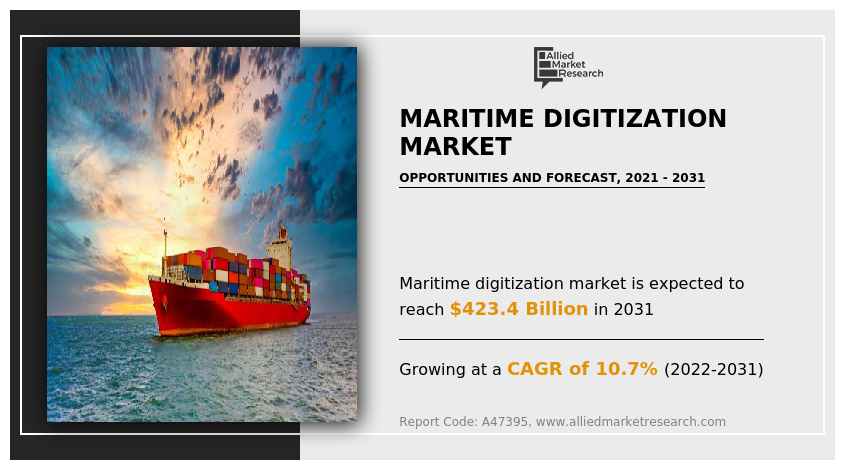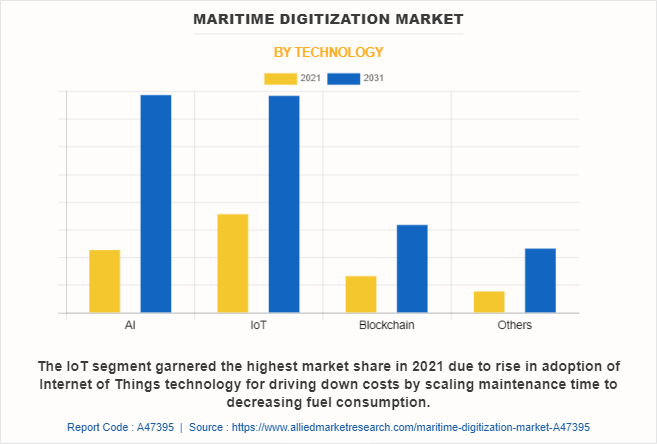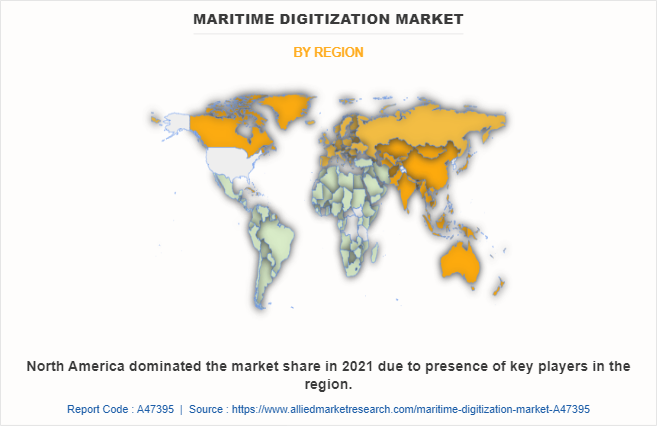Maritime Digitization Market Research, 2031
The global maritime digitization market size was valued at $157.4 billion in 2021, and is projected to reach $423.4 billion by 2031, growing at a CAGR of 10.7% from 2022 to 2031.
Increasing demand for efficiency and cost reduction is driving the maritime digitization market growth. Digitization allows for automation of processes and data analysis, which can lead to increased efficiency and cost savings in the maritime industry. Moreover, digitization can enable better communication and coordination between different stakeholders in the maritime industry, such as shipping companies, ports, and logistics providers, which can lead to more efficient and cost-effective operations.
In addition, the rising importance of customer satisfaction and the development of new technologies such as AI and ML is boosting digitalization in the maritime industry. However, lack of standardization and lack of qualified personnel is hampering the growth of the maritime digitization market. On the contrary, growing demand for advanced AI/ML-powered maritime digitization solutions will provide major lucrative opportunities for maritime digitization market forecast.

Maritime digitization refers to the use of digital technologies in the maritime industry to improve operations, increase efficiency, and reduce costs. This includes the use of technologies such as the Internet of Things (IoT), Artificial Intelligence (AI), blockchain, big data analytics, and cloud computing. The aim of maritime digitization is to create a more connected and intelligent maritime industry that is more efficient, sustainable, and safe. Moreover, the use of digital technologies in the maritime industry can lead to improved operational efficiencies, increased safety, and cost savings. It can also help to reduce the environmental impact of shipping operations. The maritime digitization market is segmented into Technology, Application and End User.
Segment Review
The maritime digitization market is segmented on the basis of technology, deployment mode, application and end user. By technology, it is segmented into AI, IoT, blockchain and others. By deployment mode, it is segmented into on-premise and cloud. By application, it is segmented into fleet management, vessel tracking, energy management, inventory management, and predictive maintenance. By end user, it is bifurcated into ports & terminals, shipping companies, and maritime freight forwarders. By region, it is analysed across North America, Europe, Asia-Pacific, and LAMEA.

Based on technology, the IoT segment registered the highest market share in maritime digitization industry in 2021. This is attributed to the rise in adoption rate of IoT technology to improve ship and fleet operations in multiple ways, such as optimized maintenance, cargo handling, and route planning. However, the artificial intelligence (AI) segment is expected to witness highest growth during the forecast period as artificial intelligence has many potential applications in the maritime industry, e.g., optimizing business processes, voyage planning and vessel maintenance.

Based on region, North America is the highest revenue contributor in maritime digitization market share in 2021. This is attributed to the presence of key players in the region and technological advancements in the maritime industry. However, Asia-Pacific is expected to witness the highest growth rate during the forecast period, owing to rapid expansion of internet infrastructure across the region.
Top Impacting Factors -
Increasing demand for efficiency and cost reduction
Digitization allows for automation of processes and data analysis, which can lead to increased efficiency and cost savings in the maritime industry. Moreover, digitization can enable better communication and coordination between different stakeholders in the maritime industry, such as shipping companies, ports, and logistics providers, which can lead to more efficient and cost-effective operations.
In addition, the maritime industry is becoming increasingly competitive, with new players entering the market and existing players looking for ways to differentiate themselves. This is driving companies to focus on efficiency and cost reduction in order to remain competitive. Furthermore, digitization can help to improve cargo tracking, reduce transit times, and increase the transparency of their operations, which can lead to increased customer satisfaction and improved market competitiveness.
The development of new technologies
The development of new technologies, such as the Internet of Things (IoT), artificial intelligence (AI), and blockchain, are enabling the maritime industry to digitize and automate processes in new ways. IoT is being used to connect ships, cargo, and other assets in the maritime industry, allowing for real-time monitoring and tracking of these assets. Moreover, AI is being used in the maritime industry to automate processes, such as route planning and cargo loading, as well as to analyze large amounts of data to improve decision-making.
In addition, the use of advanced sensors such as LIDAR, RADAR, ultrasonic and cameras is becoming more prevalent in the maritime industry. These sensors are used in ship navigation, cargo monitoring and autonomous ships. Therefore, these factors are driving the growth of maritime digitization market.
Rising importance of customer satisfaction
Customer satisfaction is becoming increasingly important in the maritime industry as companies are facing increased competition and a challenging global economic environment. To remain competitive, companies are looking for ways to improve their service and meet the demands of their customers. Moreover, customer satisfaction can be influenced by factors such as transit times, cargo tracking, reliability and overall service quality. Digitization can help to improve these factors by enabling real-time tracking of cargo and ships, as well as providing better communication and coordination between different stakeholders in the maritime industry, such as shipping companies, ports, and logistics providers. In addition, the use of digital platforms and digital communication channels like chatbots, social media, and mobile apps are providing new ways for companies to interact with customers and respond to their needs in a timely and efficient manner.
High initial cost and data privacy concerns of software
The software provides cutting-edge functionality and advanced applications at a high cost. For certain consumers, this price could be prohibitively expensive for purchasing maritime digitization could be out of budget for a few consumers. Moreover, many websites provide innovative functionality at the high expense of maritime digitization solutions. Thus, the high initial price is a crucial limitation for adopting maritime digitization tools. In addition, the software can be attacked with malware and is subjected to data breaches. This software can contain an infection or pose other threats to phone or computer devices, resulting in significant data loss. Hence, these factors are expected to hinder the market growth over the forecast period.
Lack of standardization and lack of qualified personnel
The maritime industry is a highly fragmented market, and there is a lack of standardization in terms of digital systems and processes. This can make it difficult for companies to adopt digital solutions and can also lead to compatibility issues between different systems. The lack of standardization can lead to inefficiencies and higher costs for companies, as they may have to invest in multiple digital systems to meet the needs of different customers and partners.
In addition, there is a lack of qualified personnel with the necessary skills to implement and maintain digital systems in the maritime industry, which can be a barrier to adoption. Furthermore, there is a lack of training programs and educational opportunities for personnel in the maritime industry to learn the skills needed to work with digital systems. Therefore, these factors are expected to impede maritime digitization market growth.
Growing demand for advanced AI/ML-powered maritime digitization solutions
The maritime digitalization market is expected to grow in the future due to increasing demand for efficient and cost-effective shipping operations, as well as the need to comply with regulations and improve safety. Some specific opportunities in this market include the use of autonomous vessels, big data analytics for cargo tracking and fleet management, and the adoption of Internet of Things (IoT) technology for real-time monitoring of ship systems. Moreover, the adoption of digital navigation systems, such as e-navigation, to improve safety and reduce the risk of collisions.
Additionally, the increasing use of digital platforms for ship-to-shore communication and the integration of blockchain technology for supply chain management are also expected to drive growth in the maritime digitalization market in the future. Furthermore, the increasing use of digital technologies in the maritime industry is expected to lead to more efficient and sustainable operations, as well as increased safety and cost savings.
Market Landscape and Trends
The maritime digitization market is a rapidly growing industry, driven by the increasing demand for more efficient and sustainable shipping operations. The use of technologies such as IoT, AI, and blockchain is becoming more widespread in the maritime industry, as companies look to improve efficiency and reduce costs. Moreover, the adoption of digital platforms for supply chain management is expected to continue to grow as they improve transparency and efficiency in logistics operations.
In addition, with the growing emphasis on sustainability, the maritime industry is focusing on reducing its carbon footprint and using sustainable energy sources. Furthermore, the maritime digitization market is expected to continue to grow in the future as more companies and organizations adopt these technologies to improve efficiency, reduce costs and enhance safety and security in the maritime industry while being more sustainable. Therefore, these are the major market trends for maritime digitization industry.
Key Benefits for Stakeholders
- This report provides a quantitative analysis of the market segments, current trends, estimations, and dynamics of the maritime digitization market analysis from 2021 to 2031 to identify the prevailing maritime digitization market opportunities.
- Market research is offered along with information related to key drivers, restraints, and opportunities.
- Porter's five forces analysis highlights the potency of buyers and suppliers to enable stakeholders to make profit-oriented business decisions and strengthen their supplier-buyer network.
- In-depth analysis of the maritime digitization market segmentation assists to determine the prevailing market opportunities.
- Major countries in each region are mapped according to their revenue contribution to the global market.
- Market player positioning facilitates benchmarking and provides a clear understanding of the present position of the market players.
- The report includes the analysis of the regional as well as global maritime digitization market trends, key players, market segments, application areas, and market growth strategies.
Maritime Digitization Market Report Highlights
| Aspects | Details |
| Market Size By 2031 | USD 423.4 billion |
| Growth Rate | CAGR of 10.7% |
| Forecast period | 2021 - 2031 |
| Report Pages | 235 |
| By Technology |
|
| By Application |
|
| By End User |
|
| By Region |
|
| Key Market Players | ORBCOMM, Windward Ltd., Lockheed Martin Corporation, Spire Global, Inc., Perle, MariApps Marine Solutions, Inmarsat Global Limited, SparkCognition, xyzt.ai, Iridium Communications Inc. |
Analyst Review
Maritime digitization refers to the process of implementing digital technologies in the maritime industry to improve efficiency, safety, and sustainability. Maritime digitization refers to the process of implementing digital technologies in the maritime industry to improve efficiency, safety, and sustainability. The goal of maritime digitization is to increase the efficiency and competitiveness of the maritime industry while also reducing its environmental impact.
Furthermore, market players are adopting acquisition strategies for enhancing their services in the market and improving customer satisfaction. For instance, in December 2022, Iridium Communications Inc. announced the service introduction of Iridium Messaging Transport (IMT), a two-way cloud-native networked data service optimized for use over Iridium Certus and designed to make it easier to add satellite connections to existing or new IoT solutions. IMT provides an IP data transport service unique to the Iridium network, designed for small-to-moderate-sized messages supporting satellite IoT applications. Integrated with Iridium Cloud Connect and Amazon Web Services (AWS), the new service can reduce development costs and speed time to market for new Iridium Connected IoT devices. This product launched helped both the companies to grow its market in terms of revenue and attract more customers.
Some of the key players profiled in the report include Inmarsat Global Limited, Iridium Communications Inc., Lockheed Martin Corporation, MariApps Marine Solutions, ORBCOMM, Perle, SparkCognition, Spire Global, Windward Ltd. and xyzt.ai. These players have adopted various strategies to increase their market penetration and strengthen their position in the maritime digitization market.
The global maritime digitization market was valued at $157.43 billion in 2021, and is projected to reach $423.36 billion by 2031, registering a CAGR of 10.7% from 2022 to 2031.
Increasing demand for efficiency and cost reduction is driving the maritime digitization market growth.
North America is the largest regional market for Maritime Digitization.
Inmarsat Global Limited, Iridium Communications Inc., Lockheed Martin Corporation, MariApps Marine Solutions, ORBCOMM, Perle, SparkCognition, Spire Global, Windward Ltd. and xyzt.ai.
The key growth strategies include product portfolio expansion, acquisition, partnership, merger, and collaboration.
Loading Table Of Content...
Loading Research Methodology...



